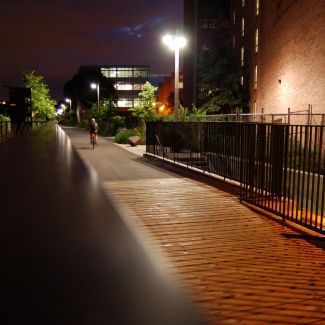Scott Torrance Landscape Architect Inc. (Prime)
Brown and Storey Architects Inc.
Formerly an abandoned rail corridor, the West Toronto Railpath acts as a transportation system and linear park for west Toronto's pedestrians and cyclists. Designed by Scott Torrance Landscape Architect Inc. with Brown and Story Architects Inc., the multi-use path spans 2.1 km across Toronto’s Junction neighbourhood. The project’s design achieves the greater goal of unifying surrounding communities, functioning as public recreational space, a connection to Toronto’s network of bike trails, and a backdrop for public art.
Utilizing indigenous plants and seeds collected from the abandoned rail corridor to create low maintenance, sustainable new landscapes, Torrance created a resilient native ecology and was able to dedicate a large portion of the project’s $3.8 million budget to the creation of high impact public spaces and neighborhood connections.
Since opening in October 2009, the space has been used for various community events such as bike rides, urban hikes and more. The Railpath’s fusion of public spaces has led to increased community involvement and has transformed an unused brownfield post-industrial space into a functional recreational area and unique experience of nature in the city.





“Toronto’s West Toronto Railpath is a significant part to the city’s growing bicycle network of trails, with nine unique plazas and trail connections. The project combines wisely the restoration of historical rail bridges with the installation of new public art, and includes a palette of indigenous planting - important elements of placemaking and character of this area of city. The Railpath had a key role in the revitalization of the once derelict industrial area improving connections, access, creating a frontage where new residential development can be located to reuse former industrial lands.
The Railpath is showing a fusion of public spaces and a new idea of ‘conciliatory public spaces’ bridging the roughness of the rail lines and the neighbourhoods it crosses. The plantings create low maintenance and sustainable landscapes that highlight the local natural heritage and allowed scarce funds to be dedicated to creating high impact public spaces and building neighbourhood connections.”